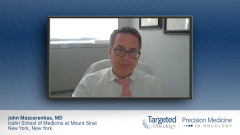
Targeting JAK2 in Myelofibrosis
Hematology/oncology experts review the role of JAK2 allele burden in patients and its effect on treatment outcomes for myelofibrosis.
Episodes in this series

Ruben Mesa, MD: Let's pivot a bit and talk about targets. First, we’ll talk about JAK2. JAK2 was the first of the described mutations in MPN [myeloproliferative neoplasm]. In a lot of ways, it was a watershed moment for all of us. In 2005, it provided a lot of diagnostic certainty for questionable cases, particularly with PV [polycythemia vera]. This was for most of the patients with PV—half with ET [essential thrombocythemia], half with MF [myelofibrosis]. We saw activation of the JAK-STAT [Janus Kinase and Signal Transducer and Activator of Transcription] pathway, and it started a very significant investment of both time and energy and resources by the pharmaceutical industry and academic partners to develop medicines that could impact this target. So the JAK inhibitors were developed with ruxolitinib and fedratinib, being some of the very earliest to be tested. But soon after came pacritinib, momelotinib, and about 6 to 10 other JAK inhibitors that were tested. We've learned as well that patients seem to respond, whether they have the JAK2 mutation or not. We learned that MPL and CALR also signal through JAK2 and that there could be similar benefits. What is sometimes surprising is learning that the JAK inhibitors are inhibitors of JAK, but they're not inhibitors of JAK2 V617F. Do you think it would make a difference if we were able to inhibit JAK2 V617F versus the general pathway?
John Mascarenhas, MD: It's an intriguing question because that's the focus of multiple laboratories throughout the world, including the Ross Levine Lab here in Manhattan, New York. We don't have a mutant selective and specific JAK2 inhibitor, but what that would actually do, one would presume that would be quite effective at least in those patients who harbor the JAK2 mutation. As you pointed out, that would only be about half of the patients with myelofibrosis. I think the real benefit as we learned early on in the development of ruxolitinib is that JAK inhibitors benefit patients who harbor the mutation, or patients who harbor alternative driver mutations like CALR or MPL. What recently has been interesting to see is something that came up early on in ruxolitinib development and now perhaps accentuated again in recent developments, is that one can look at the presence of JAK2 and the absence of JAK2 mutation, but even within those folks that have a JAK2 mutation, dose of the mutation seems to matter. Patients who have higher allele frequencies or higher burden of JAK2 mutation may have a different clinical phenotype and responsiveness to JAK inhibitor therapies than patients who have a low allele burden. So the VAF, the variant allele fraction, how much JAK2 mutation, probably influences the disease biology and therefore, the treatment outcomes of patients. For example, with ruxolitinib, it was shown years ago that patients had better spleen and symptom improvement with higher JAK2 allele burdens than those that have lower JAK2 allele burdens. That does not necessarily suggest that one wouldn't use ruxolitinib in patients across the board, but it does suggest differences in outcomes based on the mutation burden itself. More recently, we showed that pacritinib, for example, works equally well in terms of spleen volume reduction across the spectrum of JAK2 VAF and likely works better than ruxolitinib in patients who have a low VAF. So it's not simply a question of if the mutations exist. It's also the amount of mutation that's present. But I think the 1 take-home message that's very important for those folks in the community is one would not discriminate, at least currently with our armamentarium, based on the presence of a JAK2 mutation. These drugs, for the most part, are agnostic and ruxolitinib would work just as well and would be indicated in the same way if you had a patient with CALR-mutated MF in need of therapy. To move this conversation to the next level, I think it's probably important to also discuss the fact that beyond JAK2 mutations, there are multiple mutations that probably add to the complexity of the disease. Those patients who have 3 or more mutations, may not respond as well or as with such a durable response as those patients who have less complex mutation or complex disease. So, it is an evolving area of interest, which only becomes relevant as we develop more and more therapies that we can adapt to and adjust our approach based on molecular insights.
Transcript edited for clarity.








































